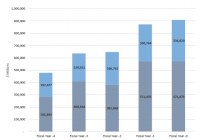Prudential Launches Unconstrained Bond Fund
By DailyAlts Staff Unconstrained bond funds have a reputation for being risky and imprudent, at least in some corners. After all, the funds are unconstrained – it’s right there in the name. But with interest rates at historic lows and widely expected to begin rising soon, holding a long-only traditional fixed-income portfolio may be the truly imprudent strategy. In light of this, Prudential Investments – a well-established firm with “prudent” right in its name – launched an unconstrained bond fund of its own on July 9: The aptly titled Prudential Unconstrained Bond Fund (MUTF: PUCAX ) . Unconstrained Prudence? Can a fund be truly both “prudential” and unconstrained? Prudential’s new fund seeks positive returns over the long term, regardless of market conditions by investing across multiple fixed-income sectors. The fund’s debt holdings are diversified within the fund, which is a prudent approach to unconstrained investing, and its aim for low correlation to traditional investment strategies – such as long-only fixed income – allows it to bring diversification benefits to existing portfolios. There’s certainly nothing imprudent about that. Minimal Constraints Calling the fund “unconstrained” is a bit of a misnomer, too, since its investment strategies do have some (very minor) constraints: For one, no more than 50% of its assets can be invested in non-U.S. fixed-income investments. The fund is also limited to a maximum of 25% of its assets invested in derivatives. And, “under normal circumstances,” at least 80% of its assets will be invested in debt instruments of some kind – these may include bonds, notes, commercial paper, mortgage-related securities, asset-backed securities, municipal bonds, loan assignments, and money market instruments. Investment Approach The fund is unconstrained in the sense that it’s not judged against a benchmark – and it has a highly flexible strategy that seeks to manage the dollar-weighted average effective duration of its holdings to between -5 and 5 years. The ability to radically adjust its positions, use leverage, and ignore benchmarks allows the fund to pursue its “unconstrained” objective of long-term positive returns regardless of market conditions. The fund’s portfolio managers can shift exposures as opportunities present themselves. Management Prudential Investment Management, a wholly owned subsidiary of Prudential Investments, is the fund’s sub-advisor. Its portfolio managers include Michael J. Collins, Gregory Peters, Richard Piccirillo, and Robert Tipp, all of whom have experience managing other funds at Prudential. Fees and Minimums Shares of the Prudential Unconstrained Bond Fund are available in A (PUCAX), C (MUTF: PUCCX ), and Z (MUTF: PUCZX ) classes. The investment management fee is 0.80% for all share classes, while the A and C shares have respective net-expense ratios of 1.15% and 1.90%, and the Class Z shares have expenses of just 0.90%. The minimum initial investment for the A and C class shares is $2,500, while Z shares’ minimum is “generally none,” according to the fund’s prospectus. For more information, view the fund’s prospectus .
